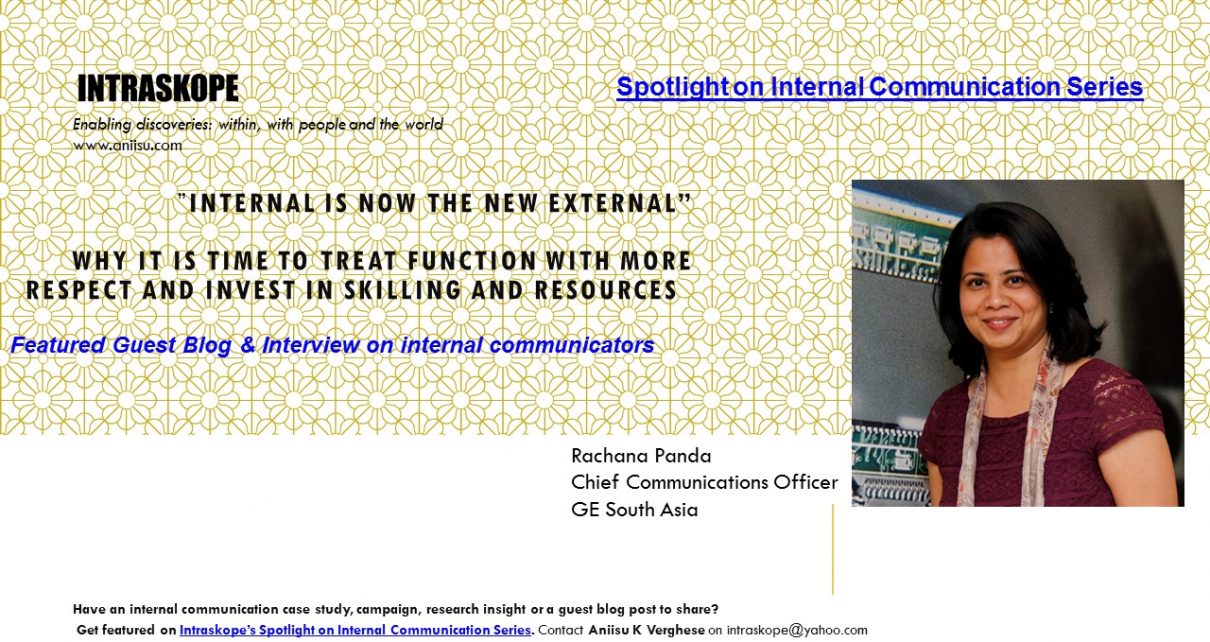Excited to share the next edition (the 7th) of Intraskope’s Spotlight on Internal Communication Series featuring Rachana Panda of GE. She reflects on the influence of employees on the brand, how internal communicators curate the culture and putting employees at the heart of communication.

In a career spanning about 20 years Rachana has worked in multiple geographies and with organizations such as Alcatel, UTStarcom and Alstom leading strategic communication, media relations, leadership engagements, internal communication, brand building and crisis communication. Do read the blog and interview below and share your thoughts.
Guest Blog
Reputation is No More Restricted to External Communication Anymore
I was doing a rushed bit of reading before a busy Wednesday morning kicked off (is there any other kind of morning?) when I came across a particularly interesting article on the recent diversity communication at Google and the action taken by the company. This got me thinking about the impact employees and their sentiments could have on a brand. Closer home we have had other brands like Mahindra which have had employee concerns (and was handled very well by the leader). Reputation is no more restricted to only external. A very sobering thought! This means as communicators, it’s time we look at the broader role of ours, much deeper than just employee engagement. Today internal communications is turning out to be a very specialized, professional and in-depth function by itself. And the best news is that we are part of this evolution.
Internal is now the new external
It’s interesting to see how a decade ago most of us never considered internal communications as a full time role but today I think every progressive company understands the role of a strong internal communicator (pls read as culture communicator). There is a single word that sums up what a person sees when they look deep inside our businesses: they see our culture. At one time, our internal culture was just that: internal. Now, there’s no such thing as ‘internal culture’ anymore. The culture of an organization is out there, larger than life and totally visible. It is a crucial part of the brand. An organization’s culture never really stands still. Like a growing child, it morphs and evolves in sync with the happenings inside the company. A company’s brand is primarily the story of its cultural journey —it’s birth, evolution, transformation, beliefs and most importantly its stakeholder perception, most critical of them being the employees. More so in the digital era, wherein everyone is a reporter or a storyteller. How we empower and leverage our employees will decide the outcome. There is no perfect way but definitely worth trying a few new ideas.
It’s all about pull strategy (push does not work anymore!)
No one lives our company culture more than our employees do, so getting them engaged is vital. At GE, we use opinion surveys & polls to understand our employees’ expectations and interests. It is seen that during transformation employees are much more likely to listen and help innovate if they feel valued and engaged. Listening is the best form of communication here. It’s not always about leader driven communications, employees are the new heroes! Research has shown how peer views is more trusted these days. While no one is contesting the value of leader communication, there are aspects when peer voice becomes more credible. One of our most interesting campaigns has been the #balancetheequation social campaign where our employees became the celebrities and leaders the followers.
Internal & external should play like a symphony
Use of digital media for internal audience is becoming more & more seamless. For most conglomerates like GE, we know that we have to constantly deal with information overload through multiple channels. At GE, Eddie (an agile internal news sharing platform named after Edison, the founder of GE) is a platform that was recently developed to develop and share content easier and simpler. Eddie is a cool, smart innovator and he facilitates every employee to become a storyteller externally as well.

Culture eats strategy for breakfast
Communication is all about creating an alignment between the big-picture goals, plans, and strategies from the top of the organization and the employee on the front line. We need special skills to drive a very thought through strategy. These are experts who are domain specialists adept in recognizing behavioral shifts, in information consumption while assessing the wisdom of using of multiple channels, have the ability to ask relevant questions to the leaders, to be able to simplify and translate the strategy for employees. And most importantly someone who can measure and analyses the data on what’s working. Now that is by no means a child’s play. In my case, I thoroughly rely on my internal communications leader and deeply value her depth of understanding of employee pulse and culture.
Internal communication is ultimately the responsibility of the CEO
With leaders realizing the importance of their relationships with their employees, it is imperative that the initiative comes from the top. The CEO has to make the time for connecting directly with his people, listen and value the inputs provided by the experts, be open to feedback and demand for more engagement. I have had the opportunity to work with the such leaders at GE, who understand this well and in fact push for innovative ways to connect with the employees be it millennials, commercial teams, diverse talent or manufacturing talent. And each of these are very different in terms of messaging and platforms. GE has developed some very interesting real time content on this over time such as the doodle series, our newest Molly ad, and “My mom works at GE”.
This is indeed an ideal time to highlight and grow the internal communications function. “Employees are our most important resource” is a phrase that has been done to death. If we really and truly stand by and commit to that sentiment, then now is the time to recommit treating them that way with a robust communication function that has the skills and resources to meet their unique and important communication needs.
Interview
- As a head of the function, what percentage of your time do you assign to internal communications?The importance of internal communications is very high and in these times of transformation it becomes paramount. The scale and focus of course, depends on the stage the company is in. Normally I would put it as 40 percent of my time. This becomes critical during leadership change or during transformation of the company where it has a renewed need to be strengthened. I always believe in going internal first.
- What would you suggest internal communicators to focus on in these evolving times?
“Strong grasp on the company strategy” and “understanding of the audience” is what I think is most needed. Most internal communicators end up spending their time in tactics and employee engagement activities. While these are important, the real value of a communicator is to drive the company culture to be able to deliver the strategy. It has to ultimately add to the business outcomes.
- Is internal communications as critical as external these days?
I would say internal communications is something new and companies are realizing its importance and potential. Those who are not, eventually will do. But internal communications means different things to different organizations. As communicators, we need to counsel and encourage our leaders to look at two way communication within organizations. Adding employee voice to the strategy and seeking opinions on outcomes are critical. To me, with growing pressures on external communications budgets, we need to look at innovative ways to involve our employees to tell the company story. That’s where internal meets external.
- Internal communication in many organizations sits with HR or marketing. What do you think about that?
I don’t really think that matters a lot. Ultimately it has to be driven from the top and executed by experts. I have seen and studied a number of cases where HR teams execute employee engagement activities (due to lack of resources). While it is no rocket science, but internal communications does need experts and a well thought through strategy. I would dare to say that most agencies can do a good job on external communication but internal communication is best delivered by specialized & dedicated communicators who understand the strategy and the pulse of the organization. There is always a general way and then there is a specialized way of doing things. The best always comes out, when you have the right skills and right focus at the right place. That’s as true in internal communications as an aspect.
If you are an internal communication practitioner working in a firm or a not-for-profit and have an internal communication case study, campaign, research insight or a guest blog post to share please contact me on [email protected]




Completely agree with Rachna. Which is why communicators need to skill themselves in all facets of communications. I decided to step out of my 8 years of comfort zone of doing external comms and plunged into internal comms and then Media. Both internal and external comms go hand in hand. One fuels the other. Good internal comms means great brand ambassadors, which translates to better external engagement.
For strategy to work, execution is critical. Execution happens if employees are engaged.
Absolutely on the dot VIKRAM! Rounded off experience gives a view to the larger picture. In this digital age, internal communications will continue to be interesting and challenging too!